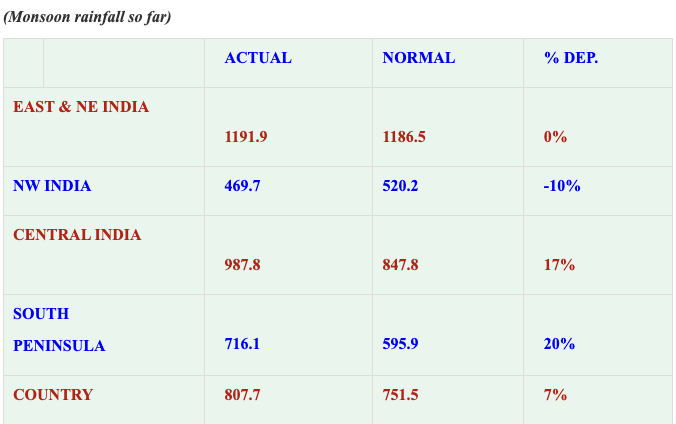
[the_ad_placement id=”adsense-in-feed”]
Monsoon likely to continue, more rain from third week of September
The IMD’s accuracy in forecasting heavy rainfall has improved to over 80 %
New Delhi: With 7 percent excess rainfall so far this year, the government expects the plentiful and spread of southwest monsoon to help farmers. It further expects the agri output must be “very good”.
[the_ad_placement id=”content-placement-after-3rd-paragraph”]
“It will also help Indian economy, though exact quantification cannot be made at this moment,” Dr. M Rajeevan, Secretary, Ministry of Earth Sciences, said on Monday.
Dr. M. Mohapatra, Director General of the India Meteorological Department (IMD), said that normal to above normal rainfall was likely in September also, though in the second week of September, monsoon rain was likely to be deficient in most parts of the country, including northwest and central India.
“But it is likely to resume after September 17,” he added. The usual date for monsoon to begin withdrawing is September 17.

Dr Mohapatra pointed out that the IMD in its weekly weather update mentioned that withdrawal of monsoon may begin from western parts of Rajasthan in the week ending September 18. “But we are also expecting a low-pressure area to develop over west central Bay of Bengal around that time,”he said, adding that while withdrawal of monsoon may begin, studies were still on as to when it was likely to completely withdraw.
“We are expecting normal to above normal rain in Kerala, Karnataka and coastal areas of Maharashtra around and after September 17,” he said. This meant that though the rainfall activity has declined in September as compared to August and was now below normal, rains will revive in the next few days as fresh weather systems were developing, he explained.
Dr. Mohapatra elaborated that variability of monsoon rain this season was higher this year, with excess rain in June, a deficit in July and again excessive rainfall in August. He said active Madden–Julian oscillation (MJO), the largest element of the intraseasonal (30- to 90-day) variability in the tropical atmosphere, and cold El Nino neutral conditions also favoured good rain in August.
He noted that the IMD’s accuracy in forecasting heavy rainfall had improved to over 80 %. Both Dr. Rajeevan and Dr. Mohapatra also pointed out that the IMD had very accurately predicted the behaviour of Super Cyclone Amphan well in advance and helped save human lives and property. However, they admitted that East and West coast cyclones were different weather patterns and tracking them minutely sometimes differed from the forecast. Though the cyclone Nisarga was also well tracked and predicted from a low pressure area to its peak, there was some difference about its landfall.
The Secretary, MoES also gave details about IMD’s efforts in installation of new and more radars across the country to gather more data and be able to make forecasts on various weather phenomena in near future.
– globalbihari bureau
[the_ad_placement id=”sidebar-feed”]






Everything is very open with a clear explanation of the issues. It was really informative. Your website is useful. Many thanks for sharing!